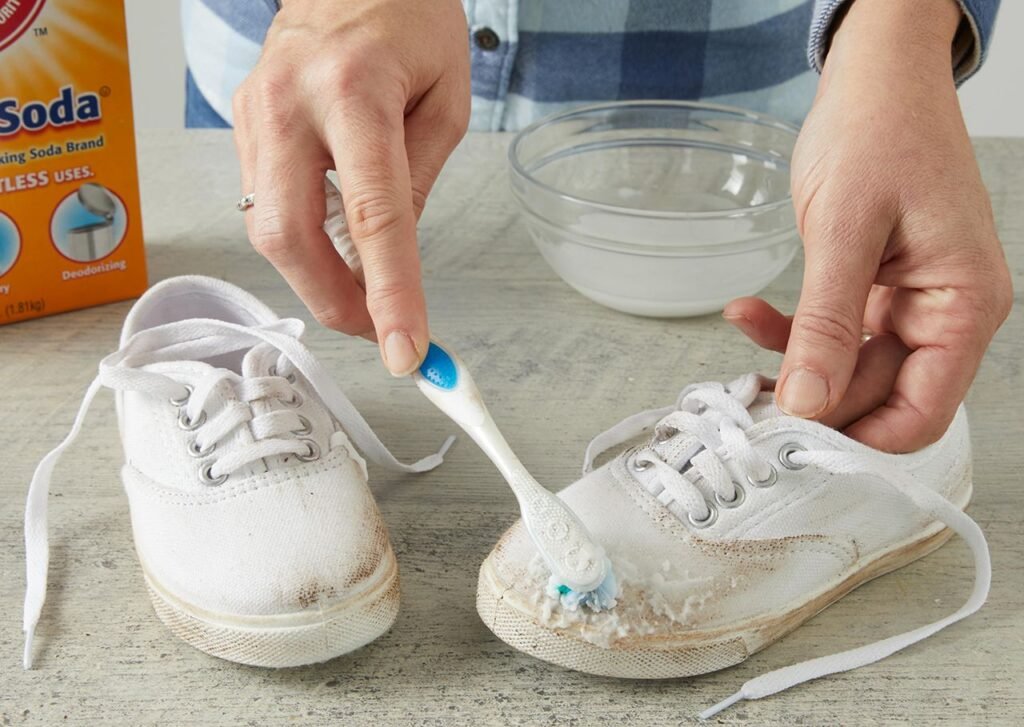How to Clean White Shoes with Toothpaste: A Step-by-Step Guide
White shoes are a classic wardrobe staple, but keeping them clean and bright can be a challenge. Whether they’re made of canvas, leather, or synthetic materials, dirt, scuff marks, and stains can quickly make them look worn out. Fortunately, you don’t have to buy expensive cleaning products to restore your shoes to their former glory. Toothpaste, an item found in most households, can be an effective and easy solution for cleaning white shoes. In this article, we’ll guide you through the process how to clean white shoes with toothpaste, providing a natural, budget-friendly, and easy method to keep your shoes looking fresh.
Why Use Toothpaste to Clean White Shoes?
Toothpaste is a surprisingly effective cleaning agent for white shoes for several reasons:
- Mild Abrasive: Toothpaste contains mild abrasives that help to remove dirt and stains from the shoe surface without causing damage.
- Stain Removal: The active ingredients in toothpaste, such as baking soda, help break down stains and grime, making it easier to scrub away marks.
- Affordable and Accessible: Toothpaste is an inexpensive solution that most people already have at home.
- Safe for Many Materials: Toothpaste can be used on various shoe materials, including canvas, rubber, and leather, without causing damage if used correctly.
What You’ll Need:
- White toothpaste (non-gel formula works best)
- Soft-bristled toothbrush or a cleaning brush
- A clean cloth or towel
- Warm water
- Bowl (optional)
Step-by-Step Guide to Cleaning White Shoes with Toothpaste
Step 1: Remove Loose Dirt and Debris
Before you start cleaning, remove any loose dirt, dust, or debris from the surface of your shoes. Use a soft brush or a dry cloth to gently wipe away any particles. This step prevents rubbing dirt into the shoe as you clean and ensures that the toothpaste can work more effectively.
Step 2: Prepare the Toothpaste
Squeeze a small amount of white, non-gel toothpaste onto a clean cloth, sponge, or directly onto the surface of the shoes. A small amount is sufficient—about the size of a quarter should be enough for one shoe. Be sure to use white toothpaste, as colored toothpastes may stain the shoes instead of cleaning them.
Step 3: Apply Toothpaste to the Shoes
Using a soft-bristled toothbrush or a small cleaning brush, gently scrub the toothpaste onto the surface of your shoes. Work in small sections, focusing on one area at a time, such as the toe box, sides, or heel. Apply light pressure, and make small circular motions to lift dirt and stains from the surface. For areas with stubborn dirt or scuff marks, apply a bit more toothpaste and scrub gently.
Step 4: Let the Toothpaste Sit
Once you’ve covered the shoes with toothpaste, let it sit for about 5 to 10 minutes. This allows the active ingredients to break down stains and grime. Be careful not to let the toothpaste dry completely on the shoe surface, as this could make it harder to remove.
Step 5: Scrub Again (If Necessary)
After the toothpaste has had a chance to sit, use your toothbrush or cleaning brush to scrub over the areas again, focusing on stubborn stains or marks. The toothpaste will continue to work as you scrub, lifting dirt and grime from the fabric.
Step 6: Wipe Away the Toothpaste
Use a damp cloth or towel to wipe off the toothpaste from your shoes. Be sure to wipe thoroughly, removing any excess toothpaste and dirt. You may need to rinse the cloth in warm water and wipe the shoes multiple times to ensure they’re free from toothpaste residue.
Step 7: Dry the Shoes
After cleaning, allow your shoes to air dry. Avoid placing them in direct sunlight or using heat sources like a hairdryer, as this can damage the material. Let them dry naturally, which will help prevent any warping or color fading.
Step 8: Repeat the Process (If Needed)
For shoes with heavy stains or built-up grime, you may need to repeat the process a few times. Each time, focus on one small section of the shoe to ensure that all dirt is effectively cleaned off.
Additional Tips for Cleaning Different Materials
- Canvas Shoes: Toothpaste works wonders on canvas shoes, which tend to accumulate dirt easily. Be gentle while scrubbing, as the fabric can sometimes become worn if scrubbed too hard.
- Leather Shoes: For leather shoes, use a soft cloth to apply the toothpaste and scrub gently with a brush. Avoid using too much toothpaste, as excess can cause discoloration.
- Rubber Soles: Toothpaste is particularly effective on rubber soles, especially when dealing with scuff marks. Scrub the rubber soles with a brush and then wipe off the excess toothpaste for a clean, bright finish.
Precautions to Keep in Mind
- Avoid Colored Toothpaste: Always use white toothpaste. Colored or gel toothpastes may leave stains on your shoes.
- Test First: If you’re unsure about how your shoes will react to toothpaste, test a small, inconspicuous area first to ensure no discoloration or damage occurs.
- Don’t Overdo It: While toothpaste is a great tool, overuse can lead to abrasive damage to the shoe’s material. Use toothpaste sparingly, and avoid excessive scrubbing.
Why This Method Works
Toothpaste’s cleaning properties come from mild abrasives, which are gentle yet effective at removing dirt and stains. The hydrogen peroxide or baking soda in toothpaste also helps to whiten the surface, making white shoes look brighter and fresher. The texture of toothpaste is soft enough not to scratch delicate materials like leather or canvas while still providing effective cleaning power.
Conclusion
Cleaning your white shoes with toothpaste is an easy, cost-effective, and eco-friendly method that gives your shoes a fresh, new look. Whether you’re dealing with scuff marks, dirt, or stains, toothpaste can work wonders on a variety of shoe materials. With a few simple steps and some common household items, your shoes will be gleaming white in no time.
